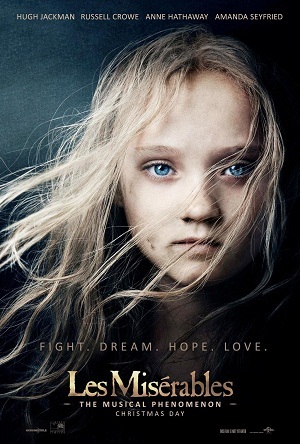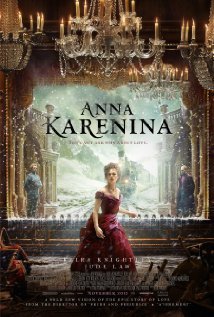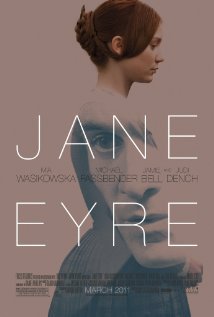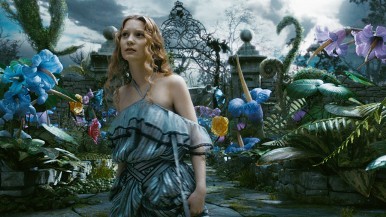
Madame Bovary (2014) film poster. Copyright: Aden Film, Aleph Motion Pictures, Left Field Ventures, Occupant Entertainment, Radiant Films International. See Wikipedia for fair use guidelines.
Madame Bovary (2014), a film by Sophie Barthes, stars Mia Wasikowska as Emma Bovary, the iconic woman created by Flaubert in his 1857 novel. Wasikowska’s name has appeared on this blog before, when she excelled in two other roles based on Fictional 100 characters: Jane Eyre and Alice in Wonderland. A little older now, she succeeds once again in embodying the unhappily married Madame Bovary.
As in Fukunaga’s Jane Eyre film, this film opens with a scene of Wasikowska running outdoors, in desperate flight from something. Both films then proceed to tell their stories in flashback. Wasikowska can certainly fill the screen with her resolute quiet; whereas as Jane Eyre this denoted her discretion and strongly principled character, as Emma Bovary, her quiet masks her restless, troubled inner life and her felt need for growing deceptions. The first changes, though, are not hidden but very visible in her acquisition–on credit–of new stylish clothes for herself and furnishings for the house she shares with her benign, country-doctor husband Charles. At first, she rebuffed the insinuating offers of Monsier Lheureux (l’heureux means “the happy one”), who tempted her to borrow from him for his expensive goods; his success at leading her into debt represents her first seduction. The romantic affairs that will follow, with “The Marquis” and Léon, are an outgrowth of this first fall from innocence. She craves the romance of luxury and love, hoping to replace the emptiness and disappointment she found in the stifling constriction of Yonville and her confining marriage. She can hardly breathe, and so her restraint and quiet demeanor break open, becoming in the end a frantic rush to destruction.
This film departs markedly from previous films and especially from Flaubert’s novel. Several crucial elements are missing:
- Berthe, the child of Emma and Charles, does not appear here. There is no mention of her having a child at all. In the novel, this fact serves to underline another area of life in which Emma could find no satisfaction. Flaubert’s Emma was unable to love or bond with her small daughter, a further wound to her marriage, which made her susceptible to falling in love with other men that crossed her path. Emma’s tragic ending is also more poignant because of the daughter she leaves behind.
- Rodolphe Boulanger is subsumed in the character of the Marquis d’Andervilliers who gives a ball early in the novel. It made more sense in the novel that farming landowner Rodolphe would be speaking (and flirting) with Emma at an agricultural fair.
- Likewise, the village of Tostes and the town of Yonville are merged. This misses that Charles was sensitive enough to Emma’s unhappiness to move to a larger, albeit still rural, setting for their life together. However, it is understandable that the screenplay for a two-hour film must make these kinds of abbreviations of plot.
- In Rouen, Emma and Léon rendezvous in the Cathedral and take a carriage to a room to make love; however, this director chose not to show us one of the novel’s most famous scenes: in which the couple make love in the closed carriage itself, as it circles around the city; Flaubert brilliantly suggests the passionate embraces inside by the sole detail of Emma’s ungloved hand in the window of the jostling carriage.
- The pharmacist Monsieur Homais’s character and behavior is sketched so roughly that viewers may not understand that he is in competition with the new doctor in town for patients, which motivates his insistence that Charles attempt a risky operation on a local boy. He is friend to neither Charles nor Emma.
- Finally, this film chooses to have Emma die alone in the forest after she has taken poison, thereby missing some of the most important scenes in the novel, and the only ones that hint at any rapprochement of the couple and a sort of redemption, in the midst of tragedy. In Flaubert’s treatment, Emma ingests a fatal dose of arsenic but takes several days to succumb, during which time she tries to comfort Charles, realizing perhaps the depth of his essential goodness and true love for her. “You’re good, not like the others,” she says to him.
Since I have listed elements I found missing in this adaptation, let me finish out this review by praising an aspect of the film that I found illuminating and symbolically satisfying. Twice, Emma goes to the local priest in his church in Yonville, hoping for some sort of guidance and comfort–neither of which she finds. The first time was especially telling: all the while she is trying to talk to him, a group of unruly children are running in the small sanctuary and the priest interrupts her to reprimand them. After he offers a few, insufficient words urging her to be happy with the roof over her head and food (and a good fellow for a husband), he sends her away, excusing himself to “get these very devils ready for Communion.” Right in front of him was a troubled young woman, being assailed by devils of her own, tempted by the Devil himself (in the form of Lheureux) and her own passions, and he couldn’t see it. She was the one who needed some real communion with grace–a compassionate confessor and some wise words of faith to strengthen her–and this priest had little to give her. If only she could have encountered a Monsieur Myriel such as appeared in the path of Jean Valjean at exactly the time when he needed him! In Emma, Flaubert portrayed some of the cracks that were appearing in traditional faith during the 19th century. His villain Homais was an atheist, and it would take more than good will and going through the motions of religion to stand up to the spiritual crisis of the people at that time (or any time!). Sophie Barthes handles these scenes between the priest and Emma with illuminating clarity for the audience, although Emma is left to plunge into her own darkness without any supports to grasp.
I recommend the film for Mia Wasikowska’s genuine portrayal of Emma and Rhys Ifan’s scary take on Lheureux. He recently played a secretive, but loyal Mycroft Holmes in the Elementary series for TV, but he is truly sinister here. The film is visually beautiful, punctuated by Emma’s stunning costumes, many of them in a fiery orange.
- Madame Bovary ranks 37th on The Fictional 100.



























Recent Comments